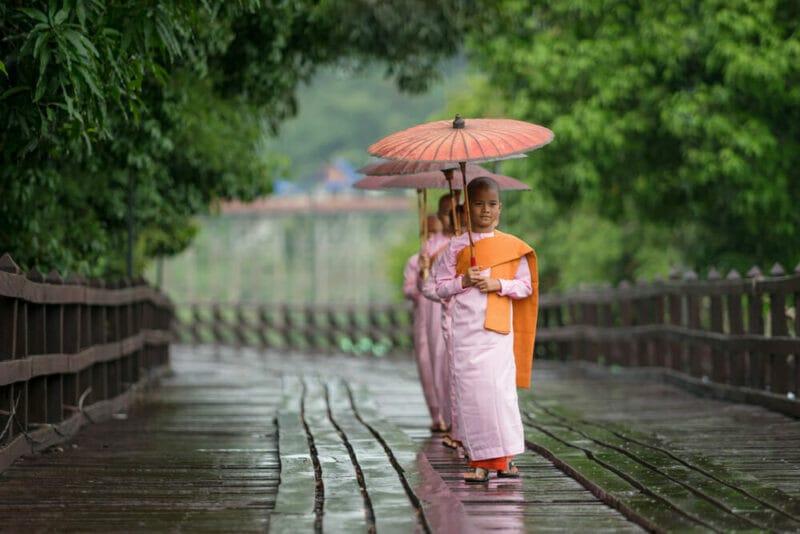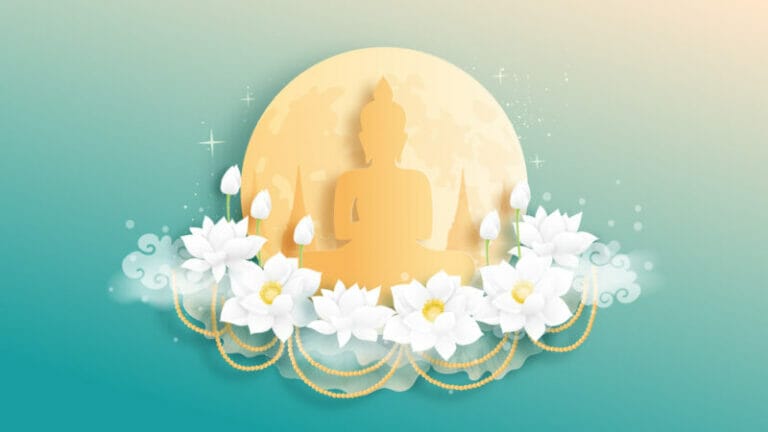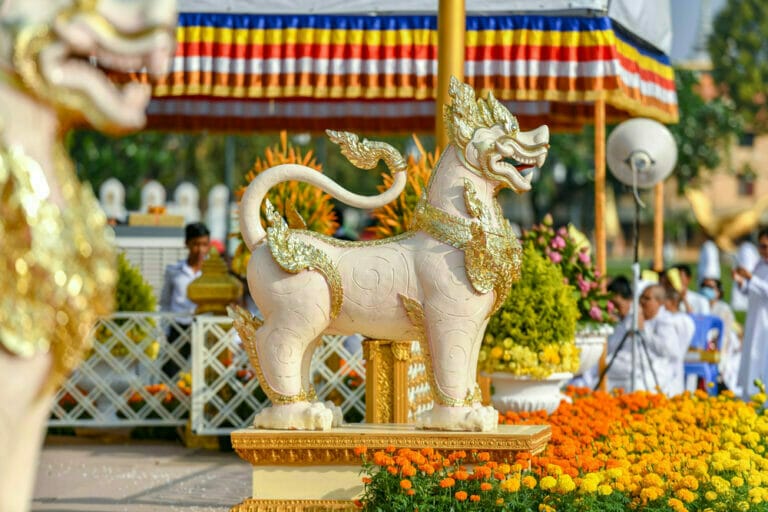Garments of Grace: Exploring Buddhist Nun Traditions Across Asia
Buddhists nuns around the world wear and follow different rules about what they can wear, with many regions having their own unique set of practices.
This blog post explains what Buddhist nuns wear in different parts of Asia. The article contains pictures and is relevant to anyone with an interest in the different types of nun clothes practiced in Buddhism.
Buddhist nuns wear what most people would consider traditional Buddhist robes. These sorts of garments are typically solid colors- such as maroon, light pink, white, yellow etc. White or light pink robes are worn by Theravada nuns. On the other hand, maroon is the traditional robe worn by monks and nuns alike in Bhutan and Nepal.

Ancestries of Buddhism
Buddhism traces its ancestry back 2500 years ago, discovering its origins in the northern regions of India. Over time it is divided into three different traditions, each one is characterized by distinct practices and apparel.
The Theravada Tradition
The oldest tradition, known as Theravada, remains dominant all over the world especially in Southeast Asia. Theravada nuns adorn themselves with robes that consist of three pieces. A sarong-like cloth that extends from waist to the ankles. It is basically wrapped around the body just like a sari, but they draped over the left shoulder. It is tied by a cotton string, adding a bodice under their robe for modesty.
Buddhist Nun Clothes (with Photos and Video)
Buddhism has established a set of dress codes for monks and nuns. In selecting Buddhist nun clothing, a number of factors are taken into consideration, such as source of the garment, the materials used to weave it, the color, the length, the width, and the height. The main reason for adhering to this dress code is to feel disciplined.
This information about the dress code is contained in two volumes of the Vinaya Pitaka (namely The Mahavagga and The Cullavagga). The Vinaya Piṭaka is one of the three parts of the Tripiṭaka.
Buddhist monks usually wear loose clothing, such as robes, so they can meditate and focus better on various Buddhist rituals. The garment worn by Buddhist monks or nuns who belong to the Theravada branch is called ‘chivara’.
A chivara essentially consists of three parts: sanghati, uttharasangha, and antharavasaka. As there are three parts, they are commonly known as ‘thecheevara’. The dress worn by a nun is not very different from that worn by a monk.
In countries with warmer climates, little change can be observed. There are nuns in these areas who can be seen using long sleeves that cover their entire upper bodies. Some nuns wear these clothes, but not all. On the other hand, the nuns in winter-prone countries usually wear long robes.
Listed below are illustrations of nun robes from Tibet, China, Japan, Myanmar, Thailand and Sri Lanka:
| Country | Image |
| Tibet |  |
| China |  |
| Japan |  |
| Myanmar |  |
| Thailand |  |
| Sri Lanka |  |
Example of Buddha Nuns’ Clothing at the Lotus Monastery
Buddhist nuns wear different robes depending on their sect and cultural background. Buddhist nuns wear robes in order to demonstrate simplicity and detachment. They take an oath of poverty, not to touch money or any other worldly goods.
Buddhist nuns are equipped for modesty as well as warmth. These clothes not only show respect for one’s faith and spirituality but they honor other people with whom we interact in society whether it be family, friends or strangers who encounter the nun on the street– or even at home if she comes to visit you.
Buddhist nuns who prefer not to look like priests still need something recognizable as part-of-the-ordained community to help maintain some sort of organization among a group of people who lead an almost completely solitary life with few other means for creating boundaries.
Buddhist Robe in Thailand
In Thailand, many Buddhist nuns choose less controversial apparel, like they used to wear a long white skirt with a long sleeved blouse and a white rectangular attire wrapped over the left shoulder.
Buddhist Robe in Burma
In Burma many nuns always like to wear saffron colored ankle length skirts. The skirt consists of a pink long-sleeved blouse and a pink cloth that is used to wrap over the left shoulder, and it is in their tradition.
Buddhist Robe in China
Chinese nuns used to wear a particular robe that consisted of a long gray tunic with loose trousers and ankle length robe that tied left over right. They find this attire easy to carry and convenient because they can change it quickly while going for a meeting with visitors.
Buddhist Robe in Japan
In Japan nuns used to wear a white single shirt that is probably sleeveless with a short tunic and a baggy trouser in gray and blue color. They carry a black ankle length robe wrapped left over right that is made from light material for all seasons.
Evolution of Robe Colors
Theravada robes symbolized different aspects of Buddhism’s tradition therefore the color of the robe varied from orange to yellow and then to ochre. It is one of the significant developments that reflect changes in cultural norms and regional preferences.
Buddhists wear different colors of robes in different regions. Although, the fabric of their robes is always made of natural fibers like wool, silk or plant fiber. However, commonly they wear three main colors – saffron, maroon and black robes.
Let us have a look at these colors and their significance.
The Saffron Robe
The Theravada Buddhists in South East Asia wear saffron-dyed robes. Moreover, it is a common belief that this color is the closest to what Buddha and his disciples wore centuries ago.
Moreover, these robes are made of a large rectangle wrapped over shoulders with a lower body sarong and an extra layer to offer warmth. Similarly, Theravada nuns also wear light pink or white robes and are generally seen during morning almsgiving gatherings.
The Maroon Robe
Maroon robes with some variation of red are commonly seen in Nepal and Bhutan. Further, Buddhists in these countries practice Tibetan Buddhism. Likewise, since these countries have mountains where temperatures are down, hence, they wear an undershirt to keep their bodies warm.
Furthermore, they also wear a red upper robe and do not participate in almsgiving.
The Black Robe
Generally, you will see black robes on Buddhists in Japan. They wear a yellow-colored top known as Kashaya that is wrapped over one shoulder. Contrarily, Zen monks wear small yellow bibs instead of a full shawl.
Frequently Asked Questions
What is a Buddhist dress called?
Kasaya is the term used to describe the name of a Buddhist dress in a brown or saffron dye. Moreover, in Sanskrit “civara” is a term that is used to describe Buddhist dresses without highlighting color.
What are Buddhist nuns called?
From the beginning, Buddhism has had an ordained ministry where each male and female had their roles. Monks are called bhikkhus whereas nuns are known as bhukkunis. Similarly, devoted lay people are called Upasaka for male and Upasika for females.
What is the dress code for Buddhism?
There is no formal dress code for Buddhism, as every temple has its own rules. However, Buddhists generally love to wear modest clothing and avoid wearing shorts, short skirts or revealing tops.
What is the dress code for Buddhism girls?
Girls generally wear modest clothes like Capri pants and long skirts. Moreover, girls dress in layers and add a scarf or shawl wherever they go. However, there is no specific dress code for Buddhist girls.
Parting Words
Buddhist nuns have renounced worldly pleasures and live a life devoted entirely to religious study, contemplation, and meditation.
Some nuns will wear simple robes while others may wear different styles of clothing depending on their culture or tradition. That’s the only physical thing that differentiates them from anyone else in society; gender, race, nationality all disappear in this instance at least.
And I think it symbolizes something really important about our journey to enlightenment – that we leave behind everything which traps us in one corner of life instead of freeing ourselves completely and living with an open spirit.







